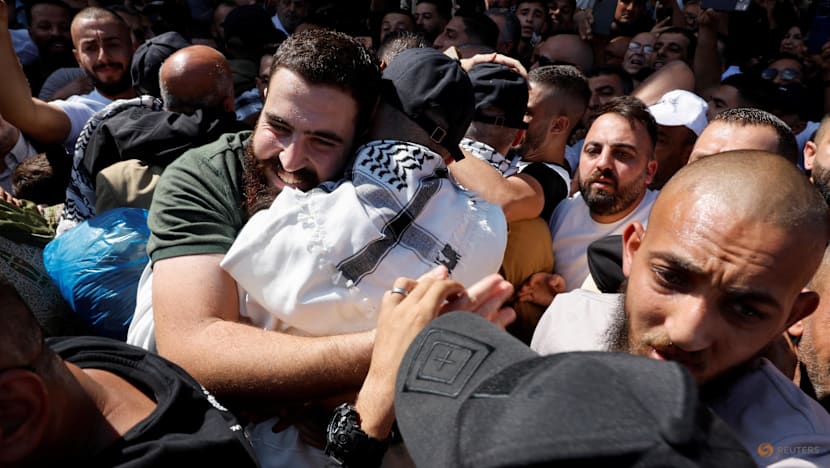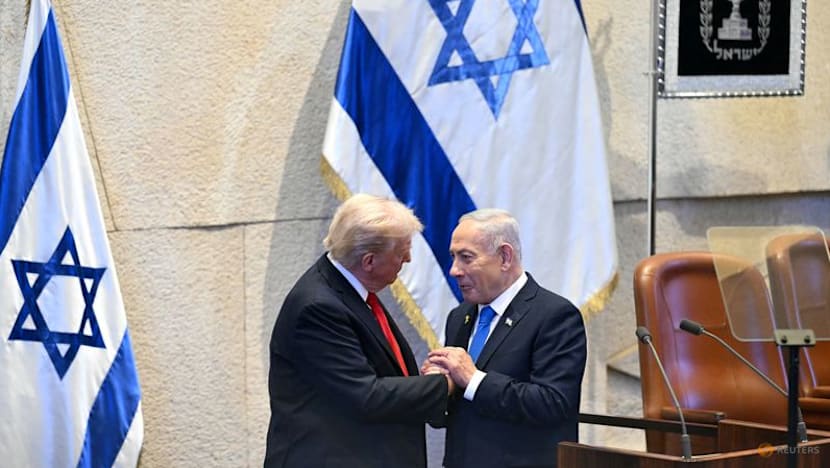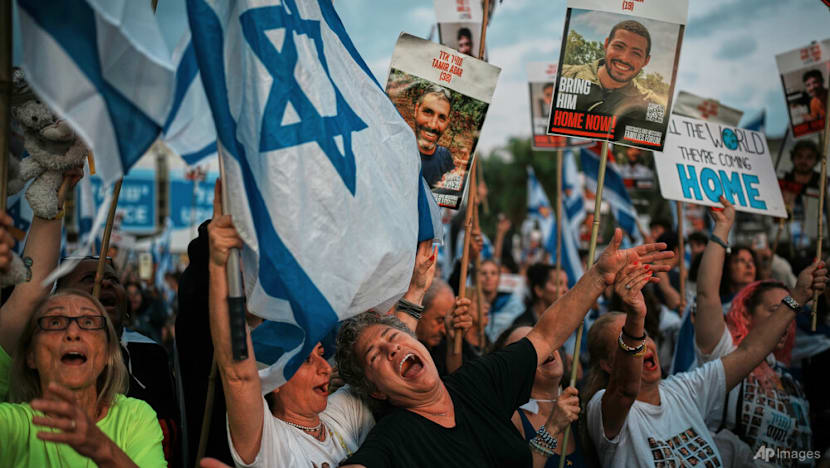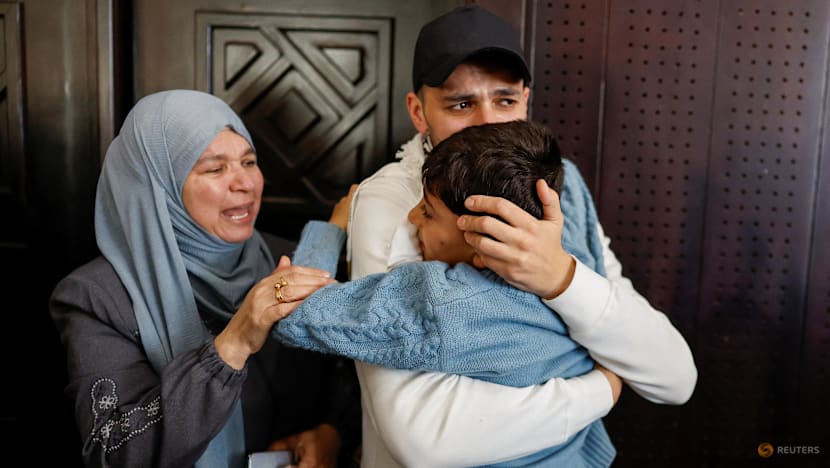Commentary: Gaza ceasefire - the difficult part comes after hostage exchange
The ceasefire and exchange of Israeli hostages and Palestinian prisoners are only the first phase of a peace plan with few concrete terms, says James Dorsey from the S Rajaratnam School of International Studies.

A freed Palestinian prisoner is greeted after he was released from an Israeli jail as part of a hostages-prisoners swap and a ceasefire deal in Gaza between Hamas and Israel, in Ramallah, in the Israeli-occupied West Bank, Oct 13, 2025. (Photo: REUTERS/Ammar Awad)

This audio is generated by an AI tool.
SINGAPORE: The exchange of Hamas-held Israeli hostages for Palestinian prisoners began on Monday (Oct 13). Now comes the difficult bit: ensuring the ceasefire equates a permanent end to the Gaza war and arrangements for post-war administration and reconstruction.
United States President Donald Trump’s 20-point plan is ultimately a declaration of principles and objectives, with no concrete terms or mechanism of implementation beyond the prisoner exchange, the fragile ceasefire and the US promise to send 200 troops (to Israel rather than Gaza) to oversee the ceasefire.
On a victory lap in Israel on Monday, Mr Trump will go to Egypt for a summit where an agreement aimed at ending the Gaza war is expected to be signed by mediating countries, with Egypt, Qatar, Turkey and the United Arab Emirates possibly committing to contributing troops too.
But who will administer post-war Gaza and what the mandate of the international stabilisation force will be remain open questions.
With no good options, Hamas has placed a risky bet on Mr Trump and other guarantors that Israel will not restart hostilities after all hostages are released.
OFF TO A SHAKY START
Things are off to a shakier-than-ideal start.
While Mr Trump has put his credibility on the line by putting his name to the peace plan, his track record is one of a short attention span. This means Israel could just bide its time if it seeks to undermine the peace plan or worse.
Moreover, while Mr Trump’s plan received support from Arab and Muslim states, they appear cautious about engaging in a process that could be seen as offering Israel a fig leaf. Many have made clear to the president that there can be no peace process without Israel committing to end its occupation of Palestinian lands and the creation of a Palestinian state. Mr Trump’s plan makes only a non-committal reference to this.
At the end of the day, no one in the Middle East, the Muslim world, Israel, or the Palestinians has wholeheartedly embraced the Trump proposal. But they recognise that it is the only game in town – so none wants to get on the wrong side of the proposal by accepting it conditionally or rejecting it out of hand.
On Israel’s part, Prime Minister Benjamin Netanyahu has so far publicly refrained from declaring that the ceasefire and prisoner exchange means an end to the war. Even after his government approved the deal, Mr Netanyahu threatened to achieve Israel's demands, including Hamas' disarmament, “the hard way".
His Cabinet has also only endorsed the proposal’s first phase, involving a ceasefire and prisoner exchange. Ironically, this limited acceptance makes it easier for Hamas to negotiate the terms of the plan's other provisions, such as the demand that the group immediately disarm.
Equally worrying is Mr Trump’s problematic practice of drafting plans without the people who will have to live with it – Palestinians.
Instead, any Gaza administrative body will likely be made up of non-aligned Palestinians and put under the guardianship of a “Board of Peace”, chaired by Mr Trump, with former British Prime Minister Tony Blair in a leading role. Palestinians may be willing to accept Mr Trump in a bid to keep him engaged, but are unlikely to accept Mr Blair, who is perceived as an Israeli frontman and complicit in the US invasion of Iraq in 2003.
MIRAGE OF LONG-TERM PEACE
If Mr Trump sees the ceasefire as the launching pad for a long-elusive resolution of the Israeli-Palestinian conflict, he will likely be disappointed.
His proposal omits any reference to the West Bank – likely as a result of Mr Netanyahu's interventions – where conflict between Israelis and Palestinians continues.



Similarly, the Trump formula risks alienating Palestinians, as public opinion has shifted towards greater support of a two-state solution. Palestinians "want anything that will stop the bloodshed", said Ramallah-based pollster Zayne Abudaka on a podcast for an online magazine of Israeli and Palestinian journalists.
He suggested that a majority of Palestinians advocated peaceful means to achieve their goals – including boycott, divestment, and sanctions against Israel, protests, and negotiations – but that armed resistance remains an option. “Armed resistance is not unpopular, it’s just not the top three,” he said.
Multiple polls also suggest that a majority of Israelis want an end to the war, but do not oppose Israel’s war conduct or Mr Netanyahu's war goals, including the depopulation of Gaza.
Perhaps the strongest sign, if one were needed, that Israel is likely to squash Mr Trump's dream of an "everlasting peace" in the Middle East would be its refusal to release Marwan Barghouti.
The decision is designed to keep Palestinians divided and weak in future negotiations. Barghouti is a leader of Al-Fatah, the backbone of the West Bank-based, internationally recognised Palestine Authority, and one of the most prominent Palestinians in Israeli prisons.
He is widely viewed as a figure who can unite the Palestinian polity. He consistently emerges in opinion polls as the most popular Palestinian leader, whom Palestinians would vote for in a presidential election ahead of Palestine Authority President Mahmoud Abbas and Hamas leaders.
GAZANS AREN’T OUT OF HARM’S WAY
Hamas has good reason to concede that it will not be part of Gaza's post-war administration. Its popularity has hit rock bottom in Gaza, even though it enjoys support on the West Bank.
Divisions within Gaza and the spectre of internal strife have gained greater prominence with the killing on Sunday of 28-year-old Saleh Al Jafarawi, a controversial social media figure and journalist with alleged links to Hamas.
Wearing a bulletproof vest that identified him as a journalist when he was killed, Mr Al Jafarawi died during clashes between Hamas and the powerful Doghmush clan. Hamas and the Doghmush have long been at loggerheads and have continued the violence in Gaza since the Israeli-Hamas ceasefire took effect.
Israel reportedly tried unsuccessfully to convince the Doghmush to join a future Gaza administration of non-aligned Palestinians that would be attentive to Israeli concerns.
For now, Gazans have a respite from the violence and greater access to desperately needed humanitarian aid. What they don’t know is whether the ceasefire is temporary or whether it constitutes an end to their two-year-long ordeal.
While the ceasefire and any signed peace plan may materialise, Gazans are not yet in the clear.
Dr James M Dorsey is an Adjunct Senior Fellow at Nanyang Technological University’s S Rajaratnam School of International Studies, and the author of the syndicated column and podcast, The Turbulent World with James M Dorsey.


















